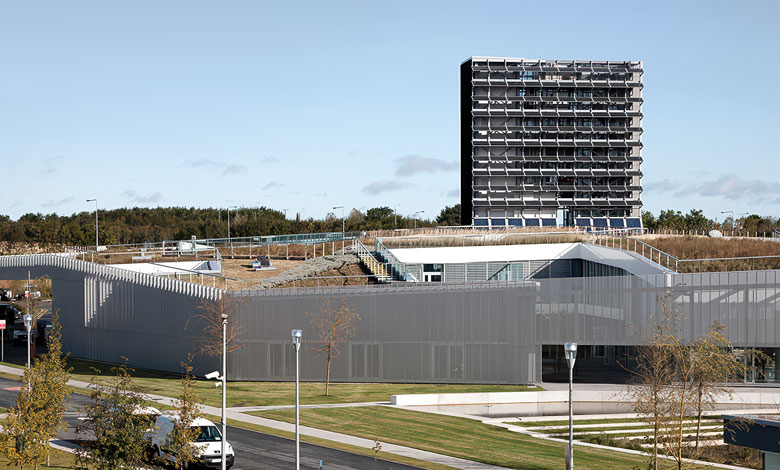
Post-2030 vision for offshore renewable energy
14th October 2025
Ireland’s commitment to the energy agenda
14th October 2025Unlocking our underground advantage: Geothermal energy

In the Networks Services Centre in Finglas, Gas Networks Ireland has achieved a pioneering sustainable building including a geothermal heat pump system linked to 27 vertical bore holes. 99kW heating capacity (COP of 4.01), Credit: Gas Network Ireland and Passivehouse plus magazine

Simon Todd, Managing Director, Causeway Energies, discusses how proven geothermal technologies can support the affordable decarbonisation of heat.
Simon Todd, Managing Director, Causeway Energies, discusses how proven geothermal technologies can support the affordable decarbonisation of heat.
The energy decarbonisation journey in both jurisdictions in the island of Ireland is reaching a pivotal juncture. We have made significant strides in greening our electricity supply – an essential achievement – but it only addresses part of the challenge. The majority of our energy demand comes not from powering our lights and appliances, but from heating our homes, our hospitals, our industry, and from cooling our data centres, supermarkets and commercial spaces. This heat and cool – collectively known as “thermal energy” – accounts for around 50 per cent of final energy use, and it is still dominated by fossil fuels most of which are imported and have, and will continue to, experience price crises. Hence decarbonisation is not just about climate. It is also about energy cost and security.
To meet this trifecta of energy decarbonisation – climate goals, energy security, and cost affordability – we surely need a stronger Single Electricity Market with ever more renewable generation. But we also need to find ways to wring every benefit out of electrification.
The good news is: geothermal is ready to complement renewable electricity generation to deliver green heat to our economy.
A proven technology hiding in plain sight
Geothermal energy has warmed (and cooled) cities around the world for decades. From the district heating of Paris to the deep aquifers of the Netherlands, from the spa towns of Germany to the Reykjavik heat network, geothermal energy has proven itself as a clean, reliable, and scalable solution for heating and cooling.
In Ireland we already have many KiloWatt-scale installations quietly saving residents money on heating bills. We also have systems at the MegaWatt scale, like the IKEA store in Ballymun, Dublin, which, unknown to most, has been heated and cooled by heat pumps from 140 boreholes under the car park since 2008. But these examples are the tip of the iceberg of what is possible.
With our high heat demands, our need for secure and affordable energy, and our varied but promising geology, the island of Ireland is ripe for a much more ambitious rollout of geothermal energy systems – both shallow and deep, for heating, and for cooling.
The opportunity for scale
There is enormous potential for geothermal energy to contribute to net zero in Ireland. Studies from the Geological Surveys of Ireland and Northern Ireland, academic institutions, and international bodies like the IEA have consistently shown that geothermal can provide decarbonised thermal energy at scale.
Shallow geothermal – using heat pumps coupled with boreholes – can serve homes, leisure centres, schools, airports and mixed-use developments. Deep geothermal, which taps heat from deeper rock formations, can serve high heat loads like hospitals, industrial processes and heat networks for urban centres.
Different supply and demand sectors can be coupled together to form GW-scale grids. Denmark has heat highways connecting cities 30km apart. Heat networks make heating and cooling an energy infrastructure of public importance and allows economies of scale to be delivered to the individual consumer.
Cooling is part of the equation
In the race to decarbonise, heating rightly gets attention. But cooling is growing rapidly – particularly in data centres, food logistics, and commercial property. In a warming climate, and with Ireland’s rapidly expanding digital economy, cooling will become a critical component of energy demand. Yet most of this cooling is currently powered by electricity and the cooling product rejected to the atmosphere as waste heat.
Geothermal technologies – including borehole thermal energy storage (BTES) and aquifer thermal energy storage (ATES) – allow us to deliver cooling sustainably, while also capturing and reusing waste heat. A data centre in Dublin could year-round provide heat to nearby homes or hospitals; during the summer a supermarket in Cork could inject waste heat from cooling for recovery to meet peak heat demand in the winter. The Netherlands has hundreds of ATES systems. Sweden, Germany, and Denmark are scaling geothermal storage to balance seasonal heating and cooling loads. It is time we did the same.
What is holding us back?
Geothermal technologies are tried and tested. The skills are in-country, or available next door. The demand is real. The costs, when capital is considered as an infrastructure investment not as an upfront burden, are competitive with gas. So what do we need to catalyse scale-up?
First, we need to make geothermal explicit in our decarbonisation plans. Current retrofit and energy efficiency schemes largely ignore the potential for geothermal to reduce the demands on the consumer’s bills and electricity supply. Heat networks are being planned without full consideration of how local geothermal sources could reduce cost and emissions. And planning frameworks are often more of a hindrance than a help. Efforts by both geological surveys have clearly helped demystify the scientific aspects of the “heat beneath our feet”. More demonstration is now needed, real projects with pioneer and early adopter customers in each heat demand sector, showing the way to their neighbours. And we need to recognise that to kickstart the sector, we need to supplement local capability with international experience.
Second, we lack a joined-up policy and regulatory framework that treats geothermal as the valuable natural resource it is and provides confidence to investors to deploy capital. In Ireland, the long-awaited policy and licensing framework needs to move from consultation to action – we hope this year. In Northern Ireland, we believe that pioneer projects can be developed in “pathfinder” collaborations to develop best practice, policy and regulations in unison. Even the act of installing policy with clear ministerial support will be a strong signal to both sides of the market, demand and supply.
Third, commercial frameworks for development and operation must evolve from procured construction projects to energy infrastructure asset development. Shifting the business models towards Energy as a Service will enable consumer cost benefits and investor returns.
The way forward
We are at an inflection point in the energy transition. We have set ambitious targets for net zero that is as much about heat as it is power. More renewable generation and an upgraded grid are key, but insufficient on its own. We need a diverse mix of technologies to meet the challenges of decarbonising heat and geothermal must be one of them.
E: contact@causewaygt.com
W: www.causewaygt.com

